Introduction to Node MCU as a brain of Internet of Things
Download as PPTX, PDF0 likes13 views
Internet of Things
1 of 19
Download to read offline
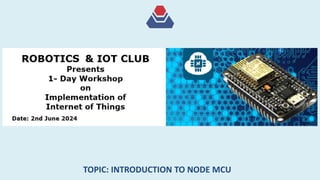

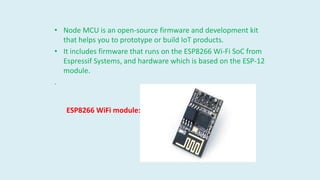



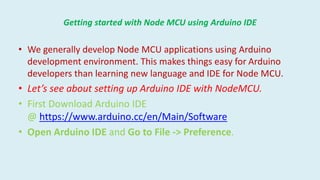












Recommended
Taller IoT en la Actualidad



Taller IoT en la ActualidadLaurence HR
?
This document discusses Arduino and its history and applications. It notes that Arduino was created in 2005 as an educational open-source hardware project. It was developed by Massimo Banzi and others to provide a low-cost, easy-to-use platform for prototyping that could be used in classrooms. Arduino was built upon Wiring, an earlier open-source electronics platform, to make hardware programming more approachable. It has since grown into a large community and product line used widely for hardware prototyping, especially in IoT and home automation applications.Wi-Fi Esp8266 nodemcu 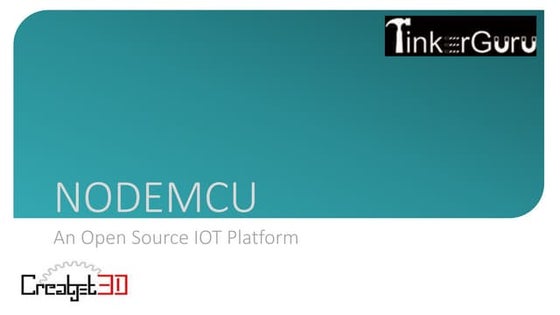



Wi-Fi Esp8266 nodemcu creatjet3d labs
?
The NodeMCU is an open-source IoT development kit that allows users to prototype IoT products using a few lines of Lua script. It contains an ESP8266 WiFi SoC, programmable GPIO pins, 32KB RAM, 80KB DRAM, and 200KB flash memory. The NodeMCU can be programmed via C or Lua and connect to devices via WiFi or by connecting pins to sensors and actuators. It provides a low-cost way to build an interactive and programmable smart device with WiFi connectivity.ESP8266 Wifi Nodemcu 



ESP8266 Wifi Nodemcu creatjet3d labs
?
The NodeMcu is an open-source firmware and development kit that helps you to Prototype your IOT product within a few Lua script lines.
Node mcu- Robocraze.pptx



Node mcu- Robocraze.pptxJOJOSENSEI
?
The ESP32 Development Board with Wifi and Bluetooth is a low-footprint, minimal system development board powered by the latest ESP-WROOM-32 module and can be easily inserted into a solderless breadboard.
It includes the ESP-entire WROOM-32's basic support circuitry, including the USB-UART bridge, reset and boot-mode buttons, an LDO regulator, and a micro-USB connector. The developer has access to every.........Introduction to Arduino Programming: Features of Arduino



Introduction to Arduino Programming: Features of ArduinoAbhimanyu Sangale
?
Introduction to Arduino Programming: Features of Arduino, Board details, Setup and IDE: -
Arduino is a software as well as hardware platform that helps in making electronic projects. It is an opensource platform and has a variety of controllers and microprocessors. There are various types of Arduino boards used for various purposes.
The Arduino is a single circuit board, which consists of different interfaces or parts. The board consists of the set of digital and analog pins that are used to connect various devices and components, which we want to use for the functioning of the electronic devices. Road to RIoT 2017 Medan



Road to RIoT 2017 MedanAlbert Suwandhi
?
This document provides an introduction to getting started with Internet of Things (IoT) development using an ESP8266 microcontroller board. It discusses what IoT is, common IoT architecture and tools, and demonstrates controlling an on-board LED from a Blynk mobile app. The demo connects an ESPectro Core board to the Blynk server and mobile app, allowing the LED to be toggled via a virtual button. Overall, the document offers a high-level overview of IoT and a simple first project to build an IoT device with an ESP8266 and Blynk.lesson1 - Getting Started with ESP8266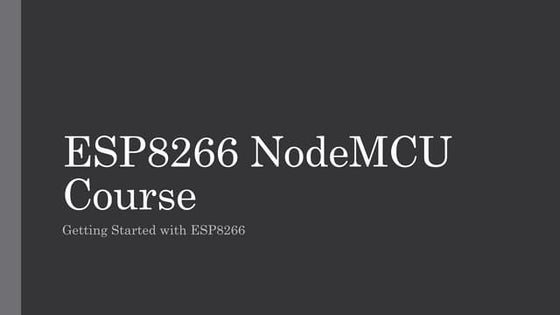



lesson1 - Getting Started with ESP8266Elaf A.Saeed
?
lesson1 - Getting Started with ESP8266
1- What is NodeMCU.
2- NodeMCU Instillation in Arduino IDE.
3- Simple Projects with NodeMCU (Sensors & Actuators)
4- NodeMCU with Communication protocols.
5- Connection NodeMCU with Wi-Fi.
6- Use NodeMCU as Clients & Server.
7- Different Platform uses with IOT application.ESP32 WiFi & Bluetooth Module - Getting Started Guide



ESP32 WiFi & Bluetooth Module - Getting Started Guidehandson28
?
The document provides information about the ESP32 WiFi and Bluetooth SoC module. It discusses the ESP32's dual-core processor, integrated antennas and radios, power efficiency features, and applications in mobile devices and IoT. It also provides specifications, pinout diagrams, and instructions for integrating the ESP32 with the Arduino IDE. Examples are given for running code on the ESP32 to scan for WiFi networks and toggle an LED with a button press.Edje Project: The Software Foundation for IoT Devices



Edje Project: The Software Foundation for IoT DevicesMicroEJ
?
The Eclipse IoT Edje project includes a Hardware Abstraction Java API for the IoT embedded systems. It targets resource-constrained microcontrollers, provides ready-to-use software packages for target hardware, and defines a modular and easy to port framework.
More about Edje Project: http://www.microej.com/portfolio-item/microej-present-eclipse-edje-open-source-iot-project-eclipsecon/Esp8266 Workshop



Esp8266 WorkshopStijn van Drunen
?
Workshop given at my employer regarding the ESP8266, a nifty IoT chip. Covers some topics and some basic getting started information.IoT Intro and Demo



IoT Intro and DemoAlbert Suwandhi
?
The document discusses Internet of Things (IoT) topics including an introduction to IoT concepts and components, common IoT architectures, communication protocols like MQTT, embedded platforms like the ESP8266, and examples of IoT applications in areas such as smart farming, logistics, and environmental monitoring. It also provides an overview of the speaker's credentials and experience with embedded systems and microcontrollers and includes a demonstration of an IoT development board.Republic of IoT 2018 - ESPectro32 and NB-IoT Workshop



Republic of IoT 2018 - ESPectro32 and NB-IoT WorkshopAlwin Arrasyid
?
This document discusses NB-IoT and an ESPectro32 workshop. It introduces NB-IoT as a low power wide area network technology for IoT. It describes the ESPectro32 board and how to set up a development environment. It also discusses connecting the ESPectro32 to an NB-IoT backpack module to send telemetry data via NB-IoT networks. Code examples are provided for sending AT commands and communicating with an NB-IoT network using HTTP and MQTT protocols.Introduction to Arduino.pptx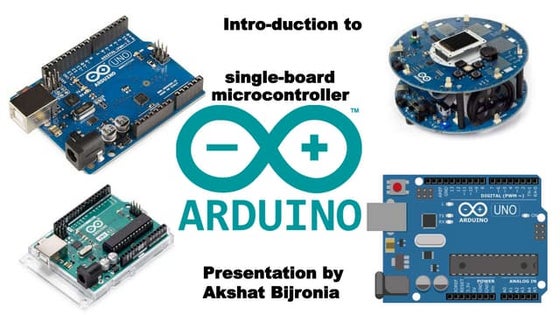



Introduction to Arduino.pptxAkshat Bijronia
?
By the end of this presentation you will be able to tell :
1. What is Arduino ?
2. Languages Supporting Arduino
3.Difference between microprocessor and microcontroller ?
4. Various different Arduino Boards
5. Arduino UNO R3 DataSheet
6. Parts and Functions of Arduino UNO R3 Board
7. Variables, functions and libraries used in Arduino board
8. Arduino Code: Blink Example
9. Applications of Arduino in real life
10. Simulators used for Arduino codingNodeMCU || Controlling and observing a robotic car with a smartphone through...



NodeMCU || Controlling and observing a robotic car with a smartphone through...Jiangxi University of Science and Technology (˝Î÷Ŕíą¤´óѧ)
?
Project link and video: https://github.com/nafizmd09/NodeMCU-controlling-and-observing-a-robotic-car-
~~~~~~~~~~~~~~~~~~~~~~~~~~~~
Name: Nafiz Md Imtiaz Uddin
B.Sc. student of Computer Science & Technology (˝Î÷Ŕíą¤´óѧ) [2019-2022]
personal Email: nafizmdimtiazuddin@yahoo.com
Academic Email: 2520190011@mail.jxust.edu.cn
~~~~~~~~~~~~~~~~~~~~~~~~~~~~
The NodeMCU board communicates to the
MIT app cloud through WiFi when the WIFI-controlled automobile is turned on. The data
will be communicated to the NodeMCU board
through the cloud when hit the Commands
(Forward, Backward, Left, Right) buttons on
the interface built in the MIT app. The gear
motors then rotate in accordance with those
values. This is done with the L298N motor
driver board. The speed of these motors may
also be changed via the MIT app's slider.
Overview of the Intel? Internet of Things Developer Kit



Overview of the Intel? Internet of Things Developer KitIntel? Software
?
The document provides an overview of the Intel Internet of Things Developer Kit. It discusses the various hardware kits available, including the Intel Galileo, Edison and various sensor kits. It also describes the software tools and libraries, cloud services, and the overall Intel IoT developer program which includes roadshows, online communities and support for developers.Introduction of Arduino Uno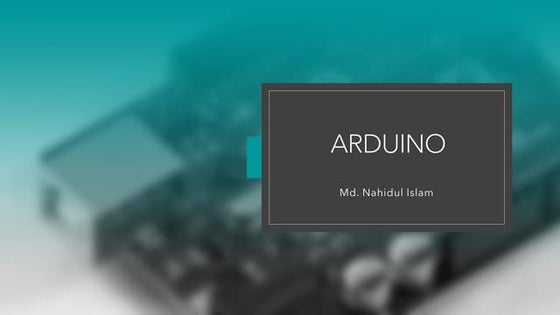



Introduction of Arduino UnoMd. Nahidul Islam
?
Arduino is an open-source electronics platform based on easy-to-use hardware and software. Arduino boards are able to read inputs - light on a sensor, a finger on a button, or a Twitter message - and turn it into an output - activating a motor, turning on an LED, publishing something online.Track 5 session 5 - st dev con 2016 - stm32 hands on seminar - cloud connec...



Track 5 session 5 - st dev con 2016 - stm32 hands on seminar - cloud connec...ST_World
?
The document provides an agenda and overview for a seminar on getting started with STM32 IoT development kits. The agenda includes presentations on STM32 portfolio overview, STM32L475 discovery board overview, STM32Cube introduction, and labs on basic tasks like blinking LEDs, Bluetooth Low Energy pairing, Wi-Fi configuration, and connecting to AWS IoT. The document describes the tools, software, and steps to install the seminar materials and required development tools like IAR workbench on participant laptops.Report



ReportIshworKhatiwada
?
The document describes a home automation system using a Node MCU and WiFi technology. The system allows users to control appliances and sensors in their home remotely through a web server or mobile application. It consists of a Node MCU module connected to sensors and actuators through a relay board. The system is scalable, allowing one server to manage multiple hardware interfaces across a WiFi network. It provides a flexible alternative to commercial home automation systems.Interoperability in Internet of Things (IOT)



Interoperability in Internet of Things (IOT)manditalaskar123
?
Interoperability in the Internet of Things refers to the ability for different devices . Different topicsWeMos D1 Mini with integrated ESP8266 has an operating



WeMos D1 Mini with integrated ESP8266 has an operatingAbhinavGurijala
?
WeMos D1 Mini with integrated ESP8266 has an operating vwireless charging of an electrical vechicle 3



wireless charging of an electrical vechicle 3hari prasad
?
This document summarizes a presentation on wireless power transmission systems and their applications. It includes an abstract, block diagrams of the system hardware, component specifications, methods for firing an inverter, simulations, and applications. It discusses using a 555 timer IC and NOT gate to generate pulses to drive an inverter for wireless power transmission. It also discusses using an Arduino board and writing a program in Arduino IDE to generate waveforms for this application.Adafruit Huzzah Esp8266 WiFi Board



Adafruit Huzzah Esp8266 WiFi BoardBiagio Botticelli
?
Presentation of the ESP8266 WiFi module created for the course Pervasive Systems 2016 of the Master Degree in Engineering in Computer Science (DIAG, University of Rome "La Sapienza")
Pervasive Systems 2016 Web Site: http://ichatz.me/index.php/Site/PervasiveSystems2016
LinkedIn Profile: https://www.linkedin.com/in/biagio-botticelli-444b87105?trk=hp-identity-name
GitHub Repository: https://github.com/biagiobotticelli/ESP8266
micocontolle based stem in the age of lton



micocontolle based stem in the age of ltonAbhinavGurijala
?
micocontolle based stem in the age of lton Peripheral Programming using Arduino and Python on MediaTek LinkIt Smart 7688...



Peripheral Programming using Arduino and Python on MediaTek LinkIt Smart 7688...MediaTek Labs
?
Want to add Wi-Fi to your IoT project? This 30 minute webinar, presented by technical consultant Ajith KP, demonstrated how to program (using Arduino and Python) for peripheral sensors connected to the MediaTek LinkIt Smart 7688 DuoˇŻs microcontroller and how to communicate between the microcontroller and the MT7688 SOC.
Three ways to undertake the peripheral programming for the MediaTek LinkIt Smart 7688 Duo were covered:
1) Using a primitive UART connection
2) Using the Firmata protocol
3) Using the Arduino Yun Bridge Library
A recording of the live event can be found at http://home.labs.mediatek.com/technical-mediatek-linkit-smart-7688-webinar-recording-available/Microcontroller based system Babc.pptx



Microcontroller based system Babc.pptxAbhinavGurijala
?
This document provides an introduction to programming the ESP8266 WiFi chip. It outlines ESP8266 basics, including an overview of the ESP-01WORKING PRINCIPLE OF ARDUINO AND USING IT AS A TOOL FOR STUDY AND RESEARCH



WORKING PRINCIPLE OF ARDUINO AND USING IT AS A TOOL FOR STUDY AND RESEARCHijdpsjournal
?
This paper explores the working principle and applications of an Arduino board. This also explores on how
it can be used as a tool for study and research works. Arduino board can provide a quick tool in
development of VLSI test bench especially of sensors. Main advantages are fast processing and easy
interface. Today, with increasing number of people using open source software and hardware devices day
after day, technology is forming a new dimension by making complicated things look easier and interesting.
These open sources provide free or virtually low costs, highly reliable and affordable technology. This paper
provides a glimpse of type of Arduino boards, working principles, software implementation and their
applications.Electronics ESP processors



Electronics ESP processorsLeopoldo Armesto
?
In this presentation we introduce some of best-known ESP electronics in the context of the IoT MOOC at EdXAll India Council of Skills and Vocational Studies (AICSVS) PROSPECTUS 2025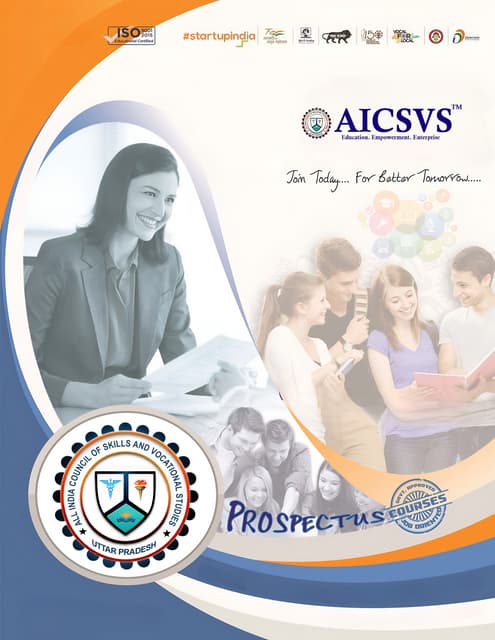



All India Council of Skills and Vocational Studies (AICSVS) PROSPECTUS 2025National Council of Open Schooling Research and Training
?
All India Council of Vocational Skills (AICSVS) and National Council of Open Schooling Research and Training (NCOSRT), Global International University, Asia Book of World Records (ABWRECORDS), International a joint Accreditation Commission of Higher Education (IACOHE)The prospectus is going to be published in the year 2025More Related Content
Similar to Introduction to Node MCU as a brain of Internet of Things (20)
Edje Project: The Software Foundation for IoT Devices



Edje Project: The Software Foundation for IoT DevicesMicroEJ
?
The Eclipse IoT Edje project includes a Hardware Abstraction Java API for the IoT embedded systems. It targets resource-constrained microcontrollers, provides ready-to-use software packages for target hardware, and defines a modular and easy to port framework.
More about Edje Project: http://www.microej.com/portfolio-item/microej-present-eclipse-edje-open-source-iot-project-eclipsecon/Esp8266 Workshop



Esp8266 WorkshopStijn van Drunen
?
Workshop given at my employer regarding the ESP8266, a nifty IoT chip. Covers some topics and some basic getting started information.IoT Intro and Demo



IoT Intro and DemoAlbert Suwandhi
?
The document discusses Internet of Things (IoT) topics including an introduction to IoT concepts and components, common IoT architectures, communication protocols like MQTT, embedded platforms like the ESP8266, and examples of IoT applications in areas such as smart farming, logistics, and environmental monitoring. It also provides an overview of the speaker's credentials and experience with embedded systems and microcontrollers and includes a demonstration of an IoT development board.Republic of IoT 2018 - ESPectro32 and NB-IoT Workshop



Republic of IoT 2018 - ESPectro32 and NB-IoT WorkshopAlwin Arrasyid
?
This document discusses NB-IoT and an ESPectro32 workshop. It introduces NB-IoT as a low power wide area network technology for IoT. It describes the ESPectro32 board and how to set up a development environment. It also discusses connecting the ESPectro32 to an NB-IoT backpack module to send telemetry data via NB-IoT networks. Code examples are provided for sending AT commands and communicating with an NB-IoT network using HTTP and MQTT protocols.Introduction to Arduino.pptx



Introduction to Arduino.pptxAkshat Bijronia
?
By the end of this presentation you will be able to tell :
1. What is Arduino ?
2. Languages Supporting Arduino
3.Difference between microprocessor and microcontroller ?
4. Various different Arduino Boards
5. Arduino UNO R3 DataSheet
6. Parts and Functions of Arduino UNO R3 Board
7. Variables, functions and libraries used in Arduino board
8. Arduino Code: Blink Example
9. Applications of Arduino in real life
10. Simulators used for Arduino codingNodeMCU || Controlling and observing a robotic car with a smartphone through...



NodeMCU || Controlling and observing a robotic car with a smartphone through...Jiangxi University of Science and Technology (˝Î÷Ŕíą¤´óѧ)
?
Project link and video: https://github.com/nafizmd09/NodeMCU-controlling-and-observing-a-robotic-car-
~~~~~~~~~~~~~~~~~~~~~~~~~~~~
Name: Nafiz Md Imtiaz Uddin
B.Sc. student of Computer Science & Technology (˝Î÷Ŕíą¤´óѧ) [2019-2022]
personal Email: nafizmdimtiazuddin@yahoo.com
Academic Email: 2520190011@mail.jxust.edu.cn
~~~~~~~~~~~~~~~~~~~~~~~~~~~~
The NodeMCU board communicates to the
MIT app cloud through WiFi when the WIFI-controlled automobile is turned on. The data
will be communicated to the NodeMCU board
through the cloud when hit the Commands
(Forward, Backward, Left, Right) buttons on
the interface built in the MIT app. The gear
motors then rotate in accordance with those
values. This is done with the L298N motor
driver board. The speed of these motors may
also be changed via the MIT app's slider.
Overview of the Intel? Internet of Things Developer Kit



Overview of the Intel? Internet of Things Developer KitIntel? Software
?
The document provides an overview of the Intel Internet of Things Developer Kit. It discusses the various hardware kits available, including the Intel Galileo, Edison and various sensor kits. It also describes the software tools and libraries, cloud services, and the overall Intel IoT developer program which includes roadshows, online communities and support for developers.Introduction of Arduino Uno



Introduction of Arduino UnoMd. Nahidul Islam
?
Arduino is an open-source electronics platform based on easy-to-use hardware and software. Arduino boards are able to read inputs - light on a sensor, a finger on a button, or a Twitter message - and turn it into an output - activating a motor, turning on an LED, publishing something online.Track 5 session 5 - st dev con 2016 - stm32 hands on seminar - cloud connec...



Track 5 session 5 - st dev con 2016 - stm32 hands on seminar - cloud connec...ST_World
?
The document provides an agenda and overview for a seminar on getting started with STM32 IoT development kits. The agenda includes presentations on STM32 portfolio overview, STM32L475 discovery board overview, STM32Cube introduction, and labs on basic tasks like blinking LEDs, Bluetooth Low Energy pairing, Wi-Fi configuration, and connecting to AWS IoT. The document describes the tools, software, and steps to install the seminar materials and required development tools like IAR workbench on participant laptops.Report



ReportIshworKhatiwada
?
The document describes a home automation system using a Node MCU and WiFi technology. The system allows users to control appliances and sensors in their home remotely through a web server or mobile application. It consists of a Node MCU module connected to sensors and actuators through a relay board. The system is scalable, allowing one server to manage multiple hardware interfaces across a WiFi network. It provides a flexible alternative to commercial home automation systems.Interoperability in Internet of Things (IOT)



Interoperability in Internet of Things (IOT)manditalaskar123
?
Interoperability in the Internet of Things refers to the ability for different devices . Different topicsWeMos D1 Mini with integrated ESP8266 has an operating



WeMos D1 Mini with integrated ESP8266 has an operatingAbhinavGurijala
?
WeMos D1 Mini with integrated ESP8266 has an operating vwireless charging of an electrical vechicle 3



wireless charging of an electrical vechicle 3hari prasad
?
This document summarizes a presentation on wireless power transmission systems and their applications. It includes an abstract, block diagrams of the system hardware, component specifications, methods for firing an inverter, simulations, and applications. It discusses using a 555 timer IC and NOT gate to generate pulses to drive an inverter for wireless power transmission. It also discusses using an Arduino board and writing a program in Arduino IDE to generate waveforms for this application.Adafruit Huzzah Esp8266 WiFi Board



Adafruit Huzzah Esp8266 WiFi BoardBiagio Botticelli
?
Presentation of the ESP8266 WiFi module created for the course Pervasive Systems 2016 of the Master Degree in Engineering in Computer Science (DIAG, University of Rome "La Sapienza")
Pervasive Systems 2016 Web Site: http://ichatz.me/index.php/Site/PervasiveSystems2016
LinkedIn Profile: https://www.linkedin.com/in/biagio-botticelli-444b87105?trk=hp-identity-name
GitHub Repository: https://github.com/biagiobotticelli/ESP8266
micocontolle based stem in the age of lton



micocontolle based stem in the age of ltonAbhinavGurijala
?
micocontolle based stem in the age of lton Peripheral Programming using Arduino and Python on MediaTek LinkIt Smart 7688...



Peripheral Programming using Arduino and Python on MediaTek LinkIt Smart 7688...MediaTek Labs
?
Want to add Wi-Fi to your IoT project? This 30 minute webinar, presented by technical consultant Ajith KP, demonstrated how to program (using Arduino and Python) for peripheral sensors connected to the MediaTek LinkIt Smart 7688 DuoˇŻs microcontroller and how to communicate between the microcontroller and the MT7688 SOC.
Three ways to undertake the peripheral programming for the MediaTek LinkIt Smart 7688 Duo were covered:
1) Using a primitive UART connection
2) Using the Firmata protocol
3) Using the Arduino Yun Bridge Library
A recording of the live event can be found at http://home.labs.mediatek.com/technical-mediatek-linkit-smart-7688-webinar-recording-available/Microcontroller based system Babc.pptx



Microcontroller based system Babc.pptxAbhinavGurijala
?
This document provides an introduction to programming the ESP8266 WiFi chip. It outlines ESP8266 basics, including an overview of the ESP-01WORKING PRINCIPLE OF ARDUINO AND USING IT AS A TOOL FOR STUDY AND RESEARCH



WORKING PRINCIPLE OF ARDUINO AND USING IT AS A TOOL FOR STUDY AND RESEARCHijdpsjournal
?
This paper explores the working principle and applications of an Arduino board. This also explores on how
it can be used as a tool for study and research works. Arduino board can provide a quick tool in
development of VLSI test bench especially of sensors. Main advantages are fast processing and easy
interface. Today, with increasing number of people using open source software and hardware devices day
after day, technology is forming a new dimension by making complicated things look easier and interesting.
These open sources provide free or virtually low costs, highly reliable and affordable technology. This paper
provides a glimpse of type of Arduino boards, working principles, software implementation and their
applications.Electronics ESP processors



Electronics ESP processorsLeopoldo Armesto
?
In this presentation we introduce some of best-known ESP electronics in the context of the IoT MOOC at EdXNodeMCU || Controlling and observing a robotic car with a smartphone through...



NodeMCU || Controlling and observing a robotic car with a smartphone through...Jiangxi University of Science and Technology (˝Î÷Ŕíą¤´óѧ)
?
Recently uploaded (20)
All India Council of Skills and Vocational Studies (AICSVS) PROSPECTUS 2025



All India Council of Skills and Vocational Studies (AICSVS) PROSPECTUS 2025National Council of Open Schooling Research and Training
?
All India Council of Vocational Skills (AICSVS) and National Council of Open Schooling Research and Training (NCOSRT), Global International University, Asia Book of World Records (ABWRECORDS), International a joint Accreditation Commission of Higher Education (IACOHE)The prospectus is going to be published in the year 2025How to process Interwarehouse and Intrawarehouse transfers in Odoo



How to process Interwarehouse and Intrawarehouse transfers in OdooCeline George
?
Inventory management is a critical component of any business that deals with physical goods. In Odoo, the Inventory module provides a comprehensive solution for managing stock, tracking inventory movements, and optimizing supply chain operations.How to Invoice Shipping Cost to Customer in Odoo 17



How to Invoice Shipping Cost to Customer in Odoo 17Celine George
?
Odoo allows the invoicing of the shipping costs after delivery and this ensures that the charges are accurate based on the real time factors like weight, distance and chosen shipping method.Action of Muscles ppt by Priscilla Jasper Vedam Vemavarapu @ASRHMC



Action of Muscles ppt by Priscilla Jasper Vedam Vemavarapu @ASRHMCjaspervedamvemavarap
?
Action of muscles-Anatomy
Contraction and relaxation
Muscle tone
Length and tension relationship
Types of muscle contraction
Active and passive insufficiency
Shunt and sprunt muscles
Agonists
Antagonists
Fixators
Synergists
Test Bank Pharmacology 3rd Edition Brenner ¨C Stevens



Test Bank Pharmacology 3rd Edition Brenner ¨C Stevensevakimworwa38
?
Test Bank Pharmacology 3rd Edition Brenner ¨C Stevens
Test Bank Pharmacology 3rd Edition Brenner ¨C Stevens
Test Bank Pharmacology 3rd Edition Brenner ¨C StevensStrategic Corporate Social Responsibility: Sustainable Value Creation Fourth



Strategic Corporate Social Responsibility: Sustainable Value Creation Fourthkeileyrazawi
?
Strategic Corporate Social Responsibility: Sustainable Value Creation Fourth
Strategic Corporate Social Responsibility: Sustainable Value Creation Fourth
Strategic Corporate Social Responsibility: Sustainable Value Creation FourthProteins, Bio similars & Antibodies.pptx



Proteins, Bio similars & Antibodies.pptxAshish Umale
?
The slides describe about the protein along with biosimilar data, which is helpful for the study respect to the subject. antibody is known to be active against antigen to show its action in treatment of various disease condition.
These slides gives you the information regarding the topic of protein, biosimilars and details about antibody in response to the antigen along with targeted drug to the antigen. As this topic data is useful for the students of sem VI who are studying in Bachelor of Pharmacy with respect to the subject Pharmacology III.Combinatorial_Chemistry.pptx by Mrs. Manjushri P. Dabhade



Combinatorial_Chemistry.pptx by Mrs. Manjushri P. DabhadeDabhade madam Dabhade
?
Introduction to combinatorial chemistry BUSINESS QUIZ | THE QUIZ CLUB OF PSGCAS | 17TH MARCH 2025 .pptx



BUSINESS QUIZ | THE QUIZ CLUB OF PSGCAS | 17TH MARCH 2025 .pptxQuiz Club of PSG College of Arts & Science
?
The Quiz club of PSGCAS brings you another fun-filled trivia ride. Presenting you a Business quiz with 20 sharp questions to feed your intellectual stimulus. So, sharpen your business mind for this quiz set
Quizmaster: Thanvanth N A, BA Economics, The Quiz Club of PSG College of Arts & Science (2023-26 batch)Bioinformatics: History of Bioinformatics, Components of Bioinformatics, Geno...



Bioinformatics: History of Bioinformatics, Components of Bioinformatics, Geno...A Biodiction : A Unit of Dr. Divya Sharma
?
Bioinformatics: History of Bioinformatics, Components of Bioinformatics, Genome Analysis, Sequence Alignment, Phylogenetic Analysis
APM London Network: Essentials of a Good PMO, 2 April 2025



APM London Network: Essentials of a Good PMO, 2 April 2025Association for Project Management
?
APM London Network: Essentials of a Good PMO, 2 April 2025
Presented by Aalok Sonawala and Magali Bruna
Whether supporting a project, programme or portfolio, a PMO brings many benefits to any project-based organisation.
During this event, we will discuss the need and importance of establishing a PMO within project-based organisations. Additionally, we will outline the different types of PMO, their key elements, and how these are best employed within an organisation.
Along with the best ways to implement PMOs, we will discuss the key benefits they can bring to your project, programme or portfolio. From ensuring your projects are effectively controlled to creating a Centre of Excellence and Best Practice guidelines.
We will delve into the key elements of PMO, such as providing guidance on topics such as Governance, Assurance and Risk, to creating design and workplace standards.
The event promises to provide valuable insights on PMOs, and also provides a great opportunity to knowledge-share ideas and network with like-minded colleagues.A-Z GENERAL QUIZ | THE QUIZ CLUB OF PSGCAS | 14TH MARCH 2025.pptx



A-Z GENERAL QUIZ | THE QUIZ CLUB OF PSGCAS | 14TH MARCH 2025.pptxQuiz Club of PSG College of Arts & Science
?
Behold a thrilling general quiz set brought to you by THE QUIZ CLUB OF PSG COLLEGE OF ARTS & SCIENCE, COIMBATORE, made of 26 questions for the each letter of the alphabet and covering everything above the earth and under the sky.
Explore the trivia , knowledge , curiosity
So, get seated for an enthralling quiz ride.
Quizmaster : THANVANTH N A (Batch of 2023-26), THE QUIZ CLUB OF PSG COLLEGE OF ARTS & SCIENCE, CoimbatoreAnti-Protozoal Agents.pptx by Mrs. Manjushri P. Dabhade



Anti-Protozoal Agents.pptx by Mrs. Manjushri P. DabhadeDabhade madam Dabhade
?
Describe the information about classification, MOA and structures of antiprotozoal agents Conrad "Accessibility Essentials: Introductory Seminar"



Conrad "Accessibility Essentials: Introductory Seminar"National Information Standards Organization (NISO)
?
This presentation was provided by Lettie Conrad of LibLynx and San Jos¨¦ University during the initial session of the NISO training series "Accessibility Essentials." Session One: The Introductory Seminar was held April 3, 2025.Anthelmintic Agent.pptx by Mrs. Manjushri P. Dabhade



Anthelmintic Agent.pptx by Mrs. Manjushri P. DabhadeDabhade madam Dabhade
?
Describe information about classification, MOA and structures of anthelmintic agents All India Council of Skills and Vocational Studies (AICSVS) PROSPECTUS 2025



All India Council of Skills and Vocational Studies (AICSVS) PROSPECTUS 2025National Council of Open Schooling Research and Training
?
BUSINESS QUIZ | THE QUIZ CLUB OF PSGCAS | 17TH MARCH 2025 .pptx



BUSINESS QUIZ | THE QUIZ CLUB OF PSGCAS | 17TH MARCH 2025 .pptxQuiz Club of PSG College of Arts & Science
?
Bioinformatics: History of Bioinformatics, Components of Bioinformatics, Geno...



Bioinformatics: History of Bioinformatics, Components of Bioinformatics, Geno...A Biodiction : A Unit of Dr. Divya Sharma
?
A-Z GENERAL QUIZ | THE QUIZ CLUB OF PSGCAS | 14TH MARCH 2025.pptx



A-Z GENERAL QUIZ | THE QUIZ CLUB OF PSGCAS | 14TH MARCH 2025.pptxQuiz Club of PSG College of Arts & Science
?
Conrad "Accessibility Essentials: Introductory Seminar"



Conrad "Accessibility Essentials: Introductory Seminar"National Information Standards Organization (NISO)
?
Introduction to Node MCU as a brain of Internet of Things
- 1. TOPIC: INTRODUCTION TO NODE MCU
- 2. NODE MCU SoC
- 3. ? Node MCU is an open-source firmware and development kit that helps you to prototype or build IoT products. ? It includes firmware that runs on the ESP8266 Wi-Fi SoC from Espressif Systems, and hardware which is based on the ESP-12 module. . ESP8266 WiFi module:
- 4. NODE MCU PIN OUT
- 5. Node MCU: ? Connect Things EASY ? An open-source firmware and development kit that helps you to prototype your IoT product. Features ? Open-source, Interactive, Programmable, Low cost, Simple, Smart, Wi-Fi enabled ? Arduino-like hardware IO
- 6. Features: ? Lowest cost Wi-Fi ? Few hundred rupees, Wi-Fi module ESP8266 integrated and easy to prototype development board. Provides a strong introductory platform for IoT application development at the lowest cost. ? The Development Kit based on ESP8266, integrates GPIO, PWM, IIC, 1- Wire and ADC all in one board.
- 7. Getting started with Node MCU using Arduino IDE ? We generally develop Node MCU applications using Arduino development environment. This makes things easy for Arduino developers than learning new language and IDE for Node MCU. ? LetˇŻs see about setting up Arduino IDE with NodeMCU. ? First Download Arduino IDE @ https://www.arduino.cc/en/Main/Software ? Open Arduino IDE and Go to File -> Preference.
- 9. Goto >> Files >> Preferences and paste following Link in "Additional boards manager URLs" http://arduino.esp8266.com/stable/package_esp8266com_index.json Then Click ok
- 12. ESP8266 BOARDˇŻS FILES INSTALLATION:
- 13. CH340G DRIVER INSTALLATION FOR THE NODE MCU BOARD: https://sparks.gogo.co.nz/ch340.html
- 14. BOARD SHOWING AT THE DEVICE MANAGER:
- 15. Node MCU 1.0 (ESP-12E Module)
- 16. Port selection before uploading
- 17. Program Environment: LED BLINKING.. void setup() { // put your setup code here, to run once: pinMode(16,OUTPUT); } void loop() { // put your main code here, to run repeatedly: digitalWrite(16,HIGH); delay(100); digitalWrite(16,LOW); delay(1000); }
- 19. Thank You!!





